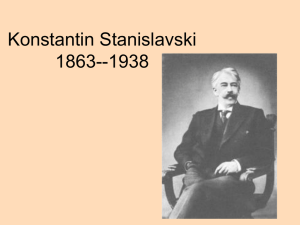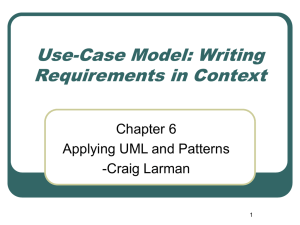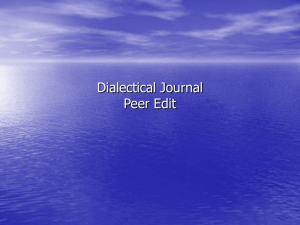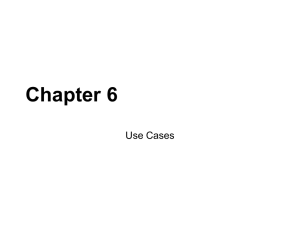IT Applications Theory Slideshows
advertisement
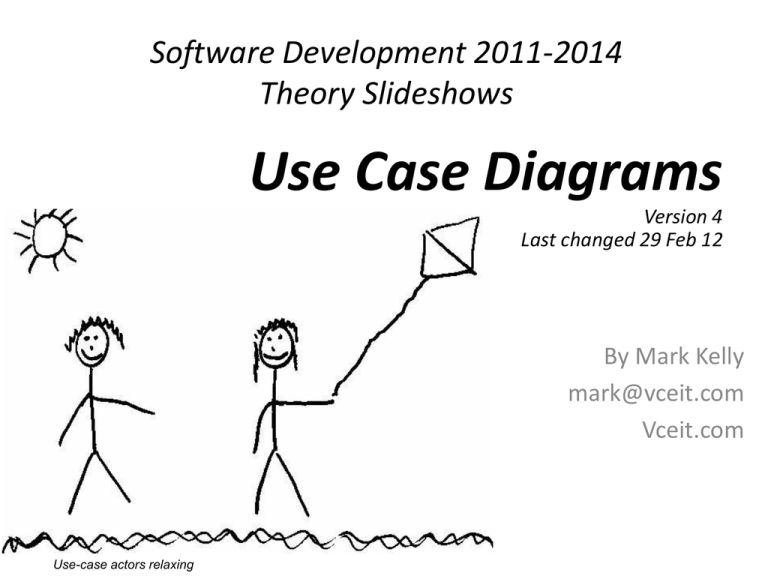
Software Development 2011-2014
Theory Slideshows
Use Case Diagrams
Version 4
Last changed 29 Feb 12
By Mark Kelly
mark@vceit.com
Vceit.com
Use-case actors relaxing
UML
• Unified Modelling Language
• A standard graphical language to model
computer applications.
• Is programming-language independent, can be
used with C++, Visual Basic, Java, Python:
anything.
UML
UML provides several types of diagrams to
represent applications under development.
– class diagram
– sequence diagram
– statechart diagram
– component diagram
– deployment diagram.
– activity diagram
And...
Use Case Diagrams!
• UCD
• The diagram we need to know for VCE SD.
• Is a picture of functional requirements in an
information system.
• Lists the tasks that a system can do.
Use Case Diagram:
• Used during analysis phase of PSM
• Maps out the functional requirements of a
system
• The emphasis is on what a system does rather
than how.
• (How is worked out during design phase of
PSM)
System?
• UCD describes what a (software) system does
from the standpoint of an external observer
who uses the system or is affected by the
system
UCD
• Serves to scope the system’s high-level
functionality
– Defines what functions will or will not be performed by the
system
– Shows developers if they have missed anything important.
• help development teams visualise the
functional requirements of a system
UCD
• Used to highlight new requirements as the
system is analysed and the design takes shape.
– E.g. “if we now want the system to do X, we’ll also
need it to do A, B and C.”
• UCD is a good tool for communicating with
clients because UCDs are so simple and easy
to read.
UCD COMPONENTS
• Actors
• Use Cases
• Associations
(communications)
• <<Includes>>,
<<extends>>
• System boundaries
ACTORS
• A person, organisation, or external system
that plays a role in the system being
developed.
• May initiate or participate in processes.
• Actors are drawn as stick figures.
• Cos stick figures are cool.
• Like ninjas, but without swords.
ACTORS
•
•
•
•
Always drawn around the edges of the UCD
The same actor only appears once in a UCD*
Must be connected to at least one process
A ‘process’ is called a Use Case.
*unlike a DFD where external entities can appear more than
once
Use Case
•
•
•
•
Pronounced “yoose case”, not “yooze case”
Drawn as an oval or circle
Name is put in the circle
Name must start with an active verb (“make”,
“open” etc)
Watch out!
• In a use case’s name don't combine sentences
with commas or 'and‘*.
• This implies that multiple actions have been
combined.
• If you see a process with an AND, snap it into
two processes
*Same rule applies in DFDs
AND
“Secretary books quote and advises customer of
the date”
AND
“Secretary books quote and advises customer of
the date”
Should be…
“Secretary books quote”
“Secretary advises customer of the date”
Associations
•
•
•
•
•
Sometimes called “communication”
Shown as a line.
Sometimes shown as arrow (more details later)
Connects an actor to a use case.
Each actor may be associated with several use
cases.
• Each use case may be associated with several
actors.
Arrowed associations
Important thing to make clear now
• Arrows do not indicate data flow!
• They are not the same meaning as in a DFD
• Assume communication is always two way
between actor and use case.
• Do not need separate arrows for each datum
(as you do in a DFD)
Arrows in UCD
• An arrow just indicates which actor initiated
the use case (the primary actor) and which
actor was affected by it starting (the passive
actor)
• With no arrow, it’s unclear which actor started
a use case...
Example
Can a patient make an appointment, or can a scheduler?
Or both?
Can a scheduler cancel an appointment?
Hard to say.
Reading a UCD
A patient calls the clinic to make an appointment.
Version 2
Arrows make it
clearer:
-Only patients
make and cancel
appointments, not
schedulers
-Patients request
medication, doctors
respond
- Clerks begin the
bill payment use
case. Patients
respond.
Note
• The lack of an arrow does not mean an actor
CANNOT initiate a use case.
• The lack of an arrow just means it’s not clear
whether the actor can initiate the use case or
not.
Quick Quiz
1. How many actors
are in this UCD?
2. How many
communications
(associations)?
3. How many use
cases?
4. Can a doctor
request that a
patient be given
medication?
Think it out...
Quick Quiz
1. How many actors
are in this UCD? 4
2. How many
communications
(associations)? 8
3. How many use
cases? 4
4. Can a doctor
request that a
patient be given
medication? Yes,
maybe.
Actors are roles, not individuals or job titles
• Mr Southerby as CEO needs access to
management information.
• Fred Smith as Order Entry Clerk needs to enter
orders.
Actors are roles, not individuals or job titles
• Sometimes Mr Southerby may need to enter
an order when Fred isn't there...
• But DON’T draw an arrow between Mr
Southerby and the Enter Order use case!
Actors are roles, not individuals or job titles
• Entering orders is not the role of the CEO.
• It’s the role of the clerk.
• So when Mr Southerby enters orders, he’s
taking on the role of Order Entry Clerk.
Actors are roles, not individuals or job titles
• The system does not know or care which
individual is entering orders.
• The system cares which agent is doing it.
• And when Mr S enters an order, he is at that
moment the agent called the ‘order entry
clerk’.
Actors are roles, not individuals or job titles
• When naming actors, think of the role that a
person takes on rather than their name or job
title.
• Most job titles involve the putting on of a
number of different hats in different situations.
• Name the actor with the role, not a job title.
Think hats!
The final UCD
More practice
1. Which actor initiates the entering of an order?
2. Which actor responds to an order being entered?
3. Is the Accounts System actor a human?
4. Who starts off the getting of an address?
5. Can the Accounts System cancel an order?
6. During order entry, does the accounts system
send information to the order entry clerk?
7. Who is the passive actor during order entry?
8. Who is the primary actor during order entry?
More practice
Which actor initiates the entering of an order?
The clerk.
More practice
Which actor responds to an order being entered?
The accounts system.
More practice
Is the Accounts System actor a human?
No, it’s an information system.
More practice
Who starts off the getting of an address?
The accounts system.
More practice
Can the Accounts System cancel an order?
No.
More practice
During order entry, does the accounts system send
information to the order entry clerk?
Yes. The arrow does not indicate the direction of
data flow.
Data flow is always 2-way (unlike a DFD)
More practice
Who is the passive actor during order entry?
The accounts system.
More practice
Who is the primary actor during order entry?
The clerk.
Another example
• What can
you deduce
from this
UCD?
Another example
• This system
lets the
band
manager
view sales
for his band,
and view the
Billboard
report.
Another example
• Using this
system, the
record
manager
can view
report on CD
sales and
view the
Billboard
report.
Another example
• The system
can retrieve
Billboard
reports from
an external
system (the
Billboard
Reporting
Service)
Another example
• The absence of use cases in this
diagram shows what the system
doesn't do.
• There is no way for a band manager
to (for example) listen to a CD
because we see no use case called
Listen to CD.
• This absence is not a trivial matter.
• It might show developers that extra
functionality is required of the
system.
<<INCLUDE>>
• Like a subprogram
• Denotes the inclusion of behaviour described
by another use case.
• Saves repetition and wasted space.
• Shown as a dotted line with “<<include>>”
label
<<INCLUDES>>
and
<<EXTENDS>>
<<INCLUDE>>
• Both the Manage
Customer Details and
Enter Order use cases
include the Find Customer
Record use case.
• They both have the
procedures from Find
Customer Record in
common.
INCLUDE and EXTEND
• Both add extra behaviour to use cases
• Like a subprogram that can be called from
various places in a program
• Always use a dotted line
The <<include>> arrow
• Arrow points from the base use case to the
included use case.
• Think of “this base use case > INCLUDES > this
use case”
Example
<<extend>>
• Like a conditional <<include>>.
• Only takes place under certain conditions.
• An <<extend>> is a use case that extends another
use case (the ‘base’ use case) when circumstances
require it.
<<extend>>
•Shown as a dotted line with “<<extend>>” label
•The condition under which the <<extend>> occurs
is shown in { } beside the line
•E.g. {if paid by credit card}
<<extend>>
Note how some
activities only
take place if
wine has been
ordered.
Note: Solid lines or arrows
between use cases are not
allowed. The only way to
link use cases is with
includes or extends.
Creating a UCD
1. Get or write the text explanation of a system:
• Clerk enters customer ID into system.
• If ID exists, account management module is
triggered.
• Otherwise, New Account module is triggered.
• Then, clerk enters a product IDs of customer's
purchase.
• If an item is not in stock, customer is advised of delay
in delivery and the back-order process is triggered.
Creating a UCD
2. Convert the text to a UCD:
•
•
•
•
•
Clerk enters customer ID into system.
If ID exists, account management module is triggered.
Otherwise, New Account module is triggered.
Then, clerk enters a product IDs of customer's purchase.
If an item is not in stock, customer is advised of delay in delivery and the
back-order process is triggered.
Enter
id
<<extend>
>
{if account
exists}
<<extend
>>
{if account
does not
exist}
clerk
Enter
purch
ases
<<extend
>> is
{if item
not in
stock}
Manage
account
Create
account
Create
back
order
Creating a UCD
• Note: this UCD was created in MS Word
• Other software – MS Visio, gliffy.com
• Easier than doing it with a pen!
Enter
id
<<extend>
>
{if account
exists}
<<extend
>>
{if account
does not
exist}
clerk
Enter
purch
ases
<<extend
>> is
{if item
not in
stock}
Manage
account
Create
account
Create
back
order
System Boundaries
• You can draw a rectangle – the system boundary around use cases to indicate the scope of the
system. They are usually not needed, but use them
anyway.
• Useful to mark off functional components that will
be rolled out in different releases of a system...
Try this
(Note: the extend lines below should be dashed.)
Are
transcripts
always
distributed
in this
system?
Explain
your
reasoning.
No.
“Distribute
Transcripts”
is an
extend, so
it is only
carried out
under some
(unknown)
conditions.
Another example to decipher
Note: do not have
arrowheads pointing
at actors! Is bad!
• Use cases: “customer uses
machine”, “maintain machine”
and “audit”
•Actors: “customer”,
maintenance engineer“,”“local
branch official” and “central
computer”.
•Actors are stick people (even
where they are machines).
Reminders
•Associations connect use
cases to 1 or more actors
•System boundary is a box
around the use cases to
separate the system (defined
by the use cases) and the
actors who are external to the
system (e.g. Users of the
system).
Reminder
•Note how headed arrows
show:
• the Local bank office
initiates the ATM
maintenance use case;
• the customer initiates the
use of the ATM;
• the use of the ATM initiates
interaction with the central
computer.
What does this tell you?
-The customer can check his status
and this involves the salesperson.
-The customer can place an order,
and this also involves the
salesperson.
-The shipping clerk fills orders using
the system.
-The customer can request credit,
and the supervisor is involved in
establishing the credit.
-Remember – all the association lines involve two way data flow.
-A data flow diagram would detail the types and directions of data
flow. The UCD does not care about that; it only worries about
users and system processes.
-Sometimes, you need to label associations to show exactly what
is happening in that association
What does this tell you?
-Catalog requests only sometimes accompany the
placing of an order.
- Supplying customer data, ordering products and
arranging payment always form part of the order
placement process.
Practice
Create a UCD to describe the following
requirements of a new system.
• Customers can contact salesmen to make a purchase.
• Salesmen enter the sale into the sales database.
• Customers can track their sale’s progress via the
database.
• The accounts department sends an invoice to the
customer.
1. Identify the actors
• Customers can contact salesmen to make a
purchase.
• Salesmen enter the sale into the sales database.
• Customers can track their sale’s progress via the
database.
• The accounts department sends an invoice to the
customer.
• All of these participants interact with the system
from the outside.
• No, the database is not an actor because it is part of
the system. It is not shown in the UCD (but it would
appear as a data store in a DFD!)
customer
salesman
Accounts dept
2. Identify the use cases
• 1. Customers can contact salesmen to make a
purchase.
• 2. Salesmen enter the sale into the sales database.
• 3. Customers can track their sale’s progress via the
database.
• 4. The accounts department sends an invoice to the
customer.
Make
purchase
Enter sale
customer
salesman
Track sales
Send
invoice
Accounts dept
Make
purchase
Enter sale
customer
Note the
customer
actor slid
down to
avoid lines
crossing or
bending!
Software
makes this
easier!
salesman
Track sales
Send
invoice
Accounts dept
Add the association lines
• Add arrows if an actor initiates the use case
Customer
initiates this
Make
purchase
Enter sale
customer
salesman
Track sales
Send
invoice
Accounts dept
Make
purchase
This action affects
the salesman
Enter sale
customer
salesman
Track sales
Send
invoice
Accounts dept
Make
purchase
Enter sale
salesman
Salesman initiates
this
customer
Track sales
Send
invoice
Accounts dept
Make
purchase
customer initiates
this
customer
Enter sale
salesman
Track sales
Send
invoice
Accounts dept
Make
purchase
Enter sale
customer
salesman
Track sales
Accounts dept
initiates this
Send
invoice
Accounts dept
Make
purchase
Enter sale
customer
This invoice sending
involves the
customer receiving it
salesman
Track sales
Send
invoice
Accounts dept
Practice
Create a UCD to describe the following
requirements of a new system in Windoze P/L.
• Customers contact the company secretary to request
a quotation
• The secretary books the quotation and advises the
customer of the date and time
• The window installer uses the system to calculate the
quotation at the customer’s house.
• The bursar processes the customer’s payment. If the
customer paid by credit card, the card needs to be
processed first.
Solution
• Customers contact the company secretary to
request a quotation
Request
quote
Use an arrowhead
because the
customer customer initiates
this
secretary
Solution
• Customers contact the company secretary to
request a quotation
Request
quote
customer
Add this association
because the
secretary becomes
involved in the use secretary
case. No
arrowhead!
Solution
• The secretary books the quotation and advises
the customer of the date and time
Request
quote
customer
Book
quote
secretary
Secretary
initiates
this, so add
arrowhead
Solution
• The secretary books the quotation and advises
the customer of the date and time
Request
quote
customer
Book
quote
Advise
customer
secretary
Secretary also initiates
this. Note that there are
two actions, so 2 use
cases. Perhaps create the
second as an <<include>>
Solution
• The secretary books the quotation and advises
the customer of the date and time
Request
quote
customer
Book
quote
Advise
customer
secretary
Solution
• The window installer uses the system to calculate
the quotation at the customer’s house.
Request
quote
Book
quote
customer
secretary
Advise
customer
Calculate
quote
installer
Solution
• The window installer uses the system to calculate
the quotation at the customer’s house.
Request
quote
Book
quote
customer
Add association to
customer who receives
the quote
secretary
Advise
customer
Calculate
quote
installer
Solution
• The bursar processes the customer’s payment
Request quote
Book quote
Advise customer
Calculate quote
customer
secretary
Process payment
Note the rearrangement to fit
everything in – this is why using
UCD software is much easier than
pen and paper!
bursar
installer
Solution
• If the customer paid by credit card, the card needs to be processed
first.
Request quote
Book quote
Advise customer
Calculate quote
customer
Process payment
<<extend>>
{if paid by credit card}
bursar
Extend is needed for
conditional extra behaviour
Process card
installer
Finished!
• Final reminder – note the
the <<extend>> arrow...
• 1. It always has an
arrowhead
• 2. The arrow points
FROM the extended use
case TO the “base use
case” (the one being
extended). Think “THIS
extends THAT”
• Compare that with an
<<include>> arrow which
points TO the additional
use case.
Process payment
<<extend>>
{if paid by credit card}
Process card
Base use case
<<include>>
Included use case
• And in their free time, ninja Use-case diagram
actors go wild...
IT APPLICATIONS SLIDESHOWS
By Mark Kelly
mark@vceit.com
vceit.com
These slideshows may be freely used, modified or distributed by teachers and students
anywhere on the planet (but not elsewhere).
They may NOT be sold.
They must NOT be redistributed if you modify them.
